Oregon White Oak Survey (Quercus garryana)
Survey Area
North of Highway 26
August 21, 2009
Submitted by . . . . . . . . . . . . . . . . . . . SaveHelvetia.org
A local citizens' group whose goal is to preserve
all land north of Highway 26 as Rural Reserves
Justification for designation as RURAL RESERVES under RR (3) (c)
Are important fish, plant or wildlife habitat per OAR 660-027-0060(3)(c)
|
RR (3) (c) Oregon White Oak Trees are an important fish, plant or wildlife habitat
Scope and Intent
At the request of the Steering Committee for SaveHelvetia.org, a citizens' group whose goal is to preserve all land north of Highway 26 in Washington County as RURAL RESERVES, we undertook an assessment of the Oregon white oak trees (Quercus garryana) north of Highway 26.
We chose to research the Oregon white oak because its presence in the area north of Highway 26 is a defining element in our landscape. Oregon white oaks can be seen throughout the area, both in grassland savanna and in oak woodlands. Some of them are massive; all are majestic. Several accounts of our area history describe events that occurred under the Five Oaks, an important gathering place near NW Helvetia Road, dating from the 1830's.
Since our initial research indicated that the Oregon white oaks have experienced a significant historical loss in numbers, we were curious as to how many were left in the area north of Highway 26. We limited our survey to an area north of Highway 26 with the following approximate boundaries:
South: Highway 26
East: Eastern edge of Washington County line
North: NW Helvetia Road and northern edge of Pumpkin Ridge Golf Course
West: NW Harrison Road, near town of Banks
Oregon Conservation Strategy
In 2006, Oregon Department of Fish and Wildlife published its first Oregon Conservation Strategy. It provides a comprehensive state strategy for conserving fish and wildlife. Previously, many plans had been used that focused on a particular species, area or natural resource. The objective of the Oregon Conservation Strategy is to ensure that Oregon's natural treasures are passed on to future generations. "The Oregon Conservation Strategy emphasizes proactively conserving declining species and habitats to reduce the possibility of future federal or state listings." (3)
According to the Oregon Conservation Strategy, "The goals of the Oregon Conservation Strategy are to maintain healthy fish and wildlife populations by maintaining and restoring functioning habitats, preventing declines of at-risk species and reversing declines in these resources where possible." (3)
|
Why is the Oregon white oak tree important?
The Oregon white oak (Quercus garryana) is important for two reasons:
- Less than 1 percent of historic Willamette Valley native oak habitats still exists. (1)
- Oregon Department of Fish and Wildlife (ODFW) has identified oak woodlands and oak savannas as "Strategy Habitats" for the Willamette Valley (3)
- Metro has identified Oregon white oak savannas and white oak woodlands as "Habitats of Concern" (1)
-
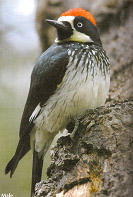
|
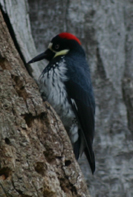
|
Acorn Woodpecker
Species of Concern (8) |
Three birds and one squirrel are dependent on the Oregon white oak for habitat
- These species are listed as Vulnerable Sensitive Species by the Oregon Department of Fish and Wildlife - facing one or more threats to their populations and/or habitats. (2)
- These Vulnerable Sensitive Species are:
Acorn Woodpecker (Melanerpes formicivorus)
White-breasted Nuthatch (Sitta carolinensis aculeata)
Western Bluebird (Sialia mexicana)
Western Gray Squirrel (Sciurus griseus)
- The Acorn Woodpecker is listed as a Species of Concern by the U.S. Fish and Wildlife Service (9)
|
Why is the Oregon white oak important to our area?
According to ODFW's Oregon Conservation Strategy, the Oregon white oak provides food and shelter for a variety of our wildlife.
Stanley H. Anderson notes in Northwest Science that "Oak-dominated forests in the western part of the Willamette Valley have a higher diversity of birds in all seasons than adjacent conifer forests." (4) This is because Oregon white oaks are open underneath their canopy, allowing for more food sources for birds, such as insects, compared to the closed, tight confines of conifers.
Oregon white oak trees played an important part in the early history of the area north of Highway 26. Mature oaks provided an abundance of food for the Atfalati and Kalapuya tribes that inhabited this area. They boiled the acorns to remove the tannins, then ground the acorns into meal or mush. Its large acorns mature in one season, ripening from late August to November.
Historically, Oregon white oaks provide a sense of place for the area north of Highway 26. The Five Oaks were a cluster of majestic oaks that played a significant part in the history of this area. Located on NW Five Oaks Drive, off NW Jacobsen Road and near NW Helvetia Road, they served as an important meeting place for early settlers of the Tualatin Plains. Early county meetings and court sessions occurred under the trees. Early pioneers believed that in the 1850's, The Five Oaks were 400 to 600 years old. They were an important stopping place for traders heading to Portland and for business transactions. Elaborate Fourth of July celebrations occurred under these trees, with settlers and members of the Atfalati and Kalapuya tribes attending. Before Oregon became a state in 1859, pioneers recorded the earliest of these gatherings beginning in 1845.
|
Effect of Urbanization on Oregon White Oaks
Urbanization poses particular problems to Oak Woodlands and Oak Savannas, according to the Oregon Conservation Strategy.
"Conversion to more urban uses increases the amount of impervious surfaces, which alter surface and water flow, degrade water quality, and reduce vegetation cover and diversity.
The changes made to the landscapes tend to be permanent and restoration to a natural state is difficult if not impossible." (3)
According to the Oregon Conservation Strategy, Habitat conversion (urban and agricultural) is the primary reason that Oak Woodlands and Oak Savannas have declined since the 1850's.
"Habitat conversion results in a matrix of unsuitable areas. For example, most of the grassland and oak woodland habitat in the Willamette Valley has been converted to agricultural, urban and rural residential uses. The remaining grassland and oak woodland patches are small, isolated and surrounded by unsuitable habitat for many species." (3) This fragmentation cannot support the species in a way conducive to survival.
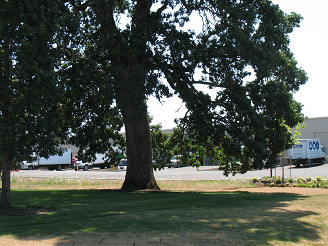
|
Historic Five Oaks now surrounded by an
industrial park in UGB north of Highway 26 |
In the publication, "Forests, Farms and People: Land Use Change on Nonfederal Lands
in Western Oregon" (2002), the authors noted that population sprawl is cause for concern, even on forest and agricultural lands.... "The report cautions that development could begin to reduce the economic and ecological benefits produced from these lands." (3)
|
Field Survey
Oregon White (Quercus garryana)
North of Highway 26
Data Collection
Gary Price, retired investigator for the Washington County Sheriff's Office, performed the field survey. We received guidance from a staff biologist at Metro as to which information we needed to collect about the Oregon white oak habitat in order to prepare a scientifically credible survey. We set out to collect the following information about each tree:
- Type of Patch
- Closed canopy. Tree tops mostly touch, little light reaches the ground. Considered oak forest
- Scattered oaks. Moderate amounts of light reaching the ground, maybe 50% tree canopy coverage.
- Oak savanna. Open, widely spaced, about 25% or less of tree canopy coverage.
- Type of Trees in each Patch
- All Oak
- Mixed trees
- Type of Understory
- Native plants: Snowberry or other native plant
- Non-native plants: Blackberry or scotchbroom, for example
- Grass or agricultural crops
- Diameter
Results
The total number of Oregon white oak trees identified in the field survey in the survey area north of Highway 26 was 3,842. There were four sites with more than 100 Oregon white oak trees in clusters, The oaks in these clusters numbered 212, 180, 325, and 244 oak trees.
| Age | Quantity of Trees |
| 50-100 years | 454 |
| 100-200 years | 781 |
| 200-300 years | 2422 |
| 300-400 years | 162 |
| 400-500 years | 13 |
| 500-700 years | 10 |
| Total | 3842 |
|---|
|
Conclusion
The area north of Highway 26 contains significant numbers of old-growth Oregon white oak trees (2607 trees are over 200 years old). As a Habitat of Concern identified by Metro and as a Strategy Habitat identified by the Oregon Department of Fish and Wildlife, the Oregon white oaks in this area serve as an important habitat that should be preserved in their rural state.
We respectfully request that Washington County and Metro designate the area north of Highway 26 as RURAL RESERVES under OAR 660-027-0060(3)(c).
|
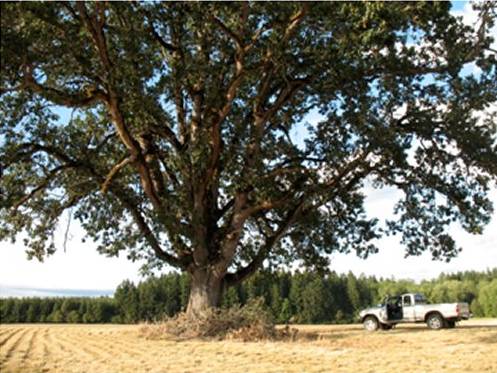 |
Oregon white oak estimated to be over 500 years old.
North of Highway 26 |
Survey Methodology
Mr. Price started the survey at the eastern-most boundary of the Candidate Urban Reserve Study Area in the 185th/Germantown/Kaiser Road area and worked his way to the western-most boundary of NW Harrison Road. He started his survey on July 16, 2009 and completed it on July 28, 2009.
Mr. Price was instructed on the proper method for identifying Quercus garryana and given leaf samples for comparison.
In order to perform an accurate count, Mr. Price utilized a mechanical "clicker", to reduce errors in under- or over-counting. His total count is conservative in nature because he was not able to enter properties with "No Trespassing" signs and, therefore, unable to count the Oregon white oaks on those properties. He discussed the project with homeowners as he encountered them and obtained their consent to enter their property to count the oaks. He noted the address for each location of oaks; where he could not determine the actual street address, he noted the closest address to the location.
|
Background
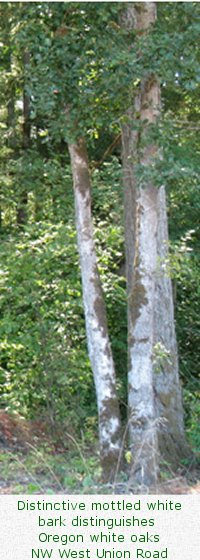
Why is the Oregon white oak special?
The Oregon Department of Forestry notes the Oregon white oak (Quercus garryana) is a deciduous hardwood tree native to Oregon, found as far north as British Columbia and as far south as southern California. Oregon white oaks have lovely, sweeping branches and their soft roundness and deep green foliage is easily discernible in a setting of mixed trees. They are able to withstand lengthy drought and are most common on sites that are either too exposed or too dry for other tree species. They are virtually fire-proof and their roots also go deeper than many other tree types. (5) Oregon white oaks are extremely slow-growing and sun loving.
In the area north of Highway 26, Oregon white oaks can be seen dotting the grass fields, in a habitat called "oak savanna". Oak savannas are grasslands with scattered Oregon white oak trees, generally only one or two trees per acre. The oak trees in savannas are usually large with well-developed limbs and canopies. (3) Entering the area on NW Helvetia Road, oak savannas can be seen on each side of the road, up to the railroad tracks. The second habitat that Oregon white oaks is found in is called "oak woodlands". An example of an oak woodland can be seen after exiting Highway 26 on the west side of NW Helvetia Road at the corner with NW Groveland. Oak woodlands typically feature clusters of trees with tall canopies of branches that touch each other.
Birds forage for insects among the variety of lichens and mosses that grow on its limbs. Mistletoe grows on its branches, providing important winter food for western bluebirds, which are listed as vulnerable sensitive species in our area. (3)
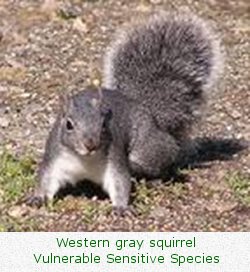 Acorns are eaten by a variety of wildlife and are particularly important in the winter, when other foods are scarce. During the fall, jays, woodpeckers and rodents bury acorns for later meals. Acorn woodpeckers and western gray squirrels feed on its acorns. (3) These two species are listed as vulnerable sensitive species in our area.
Acorns are eaten by a variety of wildlife and are particularly important in the winter, when other foods are scarce. During the fall, jays, woodpeckers and rodents bury acorns for later meals. Acorn woodpeckers and western gray squirrels feed on its acorns. (3) These two species are listed as vulnerable sensitive species in our area.
Probably the most valuable habitat features of aged Oregon white oak trees are its dead branches and cavities, which provide safe places for wildlife to rest, construct safe nests and raise young. (3).
|
Why have we lost so many Oregon white oaks?
According to Dave Vesely of Pacific Wildlife Research, Oregon white oak savannas and woodlands are among the most endangered ecological communities in the Pacific Northwest. (6) Oak habitats face several serious threats:
More than 99% of pre-settlement prairies and savannas in western Washington and Oregon have been converted to urban area, farms and other human developments.
Valley woodlands once dominated by widely-spaced oaks are slowly transforming into forests crowded with conifers and shade-intolerant trees. Oregon white oaks are unable to survive for more than a few decades in such conditions. The Oregon Conservation Strategy notes that open-canopy, large-diameter trees are continuing to be lost due to overshading by conifers, removal and natural causes, but are not being replaced. (3)
On rural landscapes, legacy oaks that persisted on pastures and woodlots for centuries are being cut down as agricultural practices intensify.
Invasive non-native plants such as Scotchbroom, Himalayan blackberry and False-Brome reduce the survival and growth rate of oak seedlings. Invasive plants also compete against wildflowers and grasses that are associated with oak habitats, thus reducing native biodiversity of the site.
|
What is being done to conserve the Oregon white oak?
Regional Level
Metro has identified Oregon white oak savannas and woodlands as "Habitats of Concern".(1) A Habitat of Concern is a habitat that has experienced a high degree of historic loss since European settlement, and is important to one or more Strategy Species. Note: Metro's Habitats of Concern are identical to the Strategy Habitats described in ODFW's Oregon Conservation Strategy.
State Level
The ODFW has listed four species in the Willamette Valley that depend on Oregon white oak habitat as "Strategy Species".
 |
Western Bluebird
Strategy Species (ODFW) (8) |
According to ODFW's Oregon Conservation Strategy, "Strategy Species" have small or declining populations or are otherwise at risk. Strategy Species is a species that depends upon a Strategy Habitat for survival. The purpose of having a conservation strategy is to prevent these species from declining further and, where possible, to restore their populations." (3) These at-risk species are:
Western grey squirrel (Sciurus griseus)
Acorn woodpecker (Melanerpes formicivorus)
Slender-billed (white-breasted) nuthatch (Sitta carolinensis aculeate)
Western bluebird (Sialia mexicana)
And, because these at-risk species depend upon Oak Woodlands and Oak Savannas for survival, the Oregon Department of Fish and Wildlife has identified Oregon white oak Woodlands and Oregon white oak Savannas as two "Strategy Habitats" for the Willamette Valley ecoregion. (3)
Federal Level
The U.S. Fish and Wildlife Service lists the Acorn Woodpecker as a Species of Concern on their "Federally Listed, Proposed, Candidate Species and Species of Concern". (9)
|
Appendices
Appendix RR3c- 1 Map of Survey Area north of Highway 26
Each of the orange dots represents a cluster of Oregon white oak trees in the survey area north of Highway 26 (the diagonal line). The code on each orange dot corresponds to an entry in the attached Oregon White Oak Survey Log. A total of 3,842 Oregon white oak trees were identified in the survey area north of Highway 26.
|
Appendix RR3c-2 Tree Ring Age Analysis - Quercus garryana
Area North of Highway 26
Three sample rounds from two different trees in the area north of Highway 26 were sampled. These tree rounds were obtained from fallen branches.
Formula for determining age:
- Count the number of rings on the radius of the round for at least 3-5 inches.
- Divide the number of rings per inch of radius counted.
- Divide the number of rings by 2 to obtain the age per inch of diameter.
- Multiply the age per inch by the total inches of diameter.
Example: 28 annual rings per 2 inches of radius of a round.
- Annual rings per inch of radius = 28 ÷ 2 = 14
- Annual rings per inch of diameter = 14 ÷ 2 = 7.0
To obtain the diameter of a tree without cutting it down, measure the circumference of the tree and divide by pi (3.14159); D = C ÷ pi
Example: 37.7 inch circumference
- Diameter in inches = 37.7 inches ÷ pi = 12 inches
- Age of tree = 7 years per inch × 12 inches = 84 years
Results
| Tree | Sample | Diameter | Years per Inch | Age in years |
| #1 | #1 | 8.5 inches | 7.8 | 66 |
| #1 | #2 | 10 inches | 7.0 | 70 |
| #2 | #3 | 22 inches | 7.2 | 159 |
|
Conclusion
Based on trees in this area, a conservative years per inch of diameter is 7.0. An average years per inch would be 7.3.
Age Table
| Circumference (inches) |
Diameter (inches) |
Conservative Age
(years) |
Average Age
(years) |
| 37.7 |
12 |
84 | 88 |
| 75.4 |
24 |
168 | 175 |
| 113.1 |
36 |
252 | 262 |
| 150.8 |
48 |
336 | 350 |
| 188.5 |
60 |
420 | 438 |
| 226.2 |
72 |
502 | 525 |
|
Works Cited
- Hennings, Lori. 2006. "State of the Watersheds Monitoring Report". Metro Regional Government. Portland, Oregon. December, 2006. P. 27
- Oregon Department of Fish and Wildlife, "Sensitive Species List". 2008.
http://www.dfw.state.or.us/wildlife/diversity/species/docs/SSL_by_category.pdf P.1-6, 13
- Oregon Department of Fish and Wildlife. 2005. Oregon Conservation Strategy. Oregon Department of Fish and Wildlife, Salem, Oregon.
- Anderson, Stanley H. 1972. "Seasonal variations in forest birds of western Oregon". Northwest Science 46(3): 194-206.
- Oregon Department of Forestry, "What's so special about Oregon White Oaks?". August 3, 2009.
http://www.oregon.gov/ODF/URBAN_Forests/docs/FeaturedTreeOregonWhiteOak.pdf
- Oregon Oak Communities Working Group. "Issues and Concerns". Dave Vesely, Pacific Wildlife Research, Corvallis, Oregon. Sec: Threats to Oak Habitats. July 23, 2009.
http://www.oregonoaks.org/issues.shtml
- McMinn and Maino, 1981. Pacific Coast Trees. University of California Press, Berkeley, California
- Nehls, Harry, Aversa, T., Opperman, H., 2004. Birds of the Willamette Valley Region., Olympia, Washington
- U.S. Fish and Wildlife Service, "Federally Listed, Proposed, Candidate Species and Species of Concern", July 20, 2009.
http://www.fws.gov/oregonfwo/Species/Lists/Documents/County/WASHINGTON%20COUNTY.pdf
|
Acknowledgements
| Editor |
Cherry Amabisca |
| Contributors |
Gary Price, Field Survey |
| |
Audrey Hatch, ODFW, Biologist |
| |
Allen Amabisca, B.A. Botany |
| |
Metro Data Resource Center |
| Photographs |
Cherry and Allen Amabisca |
Thanks to John Talbot for his assistance in preparing this document for web publication.
|
Next: Historic and Cultural Areas of Helvetia
Back to Making our case
|

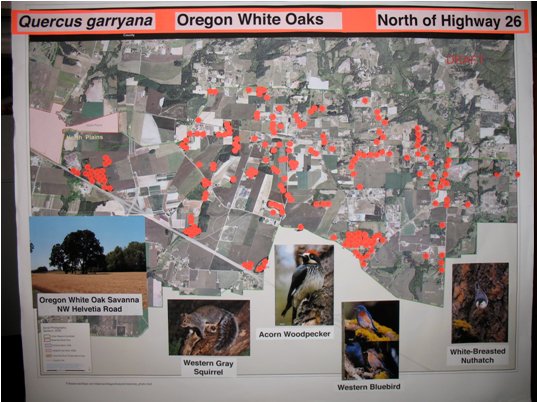









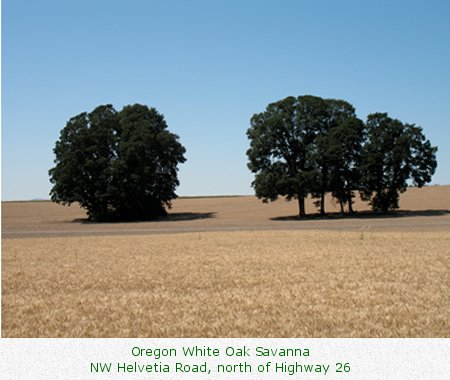




 Acorns are eaten by a variety of wildlife and are particularly important in the winter, when other foods are scarce. During the fall, jays, woodpeckers and rodents bury acorns for later meals. Acorn woodpeckers and western gray squirrels feed on its acorns.
Acorns are eaten by a variety of wildlife and are particularly important in the winter, when other foods are scarce. During the fall, jays, woodpeckers and rodents bury acorns for later meals. Acorn woodpeckers and western gray squirrels feed on its acorns. 